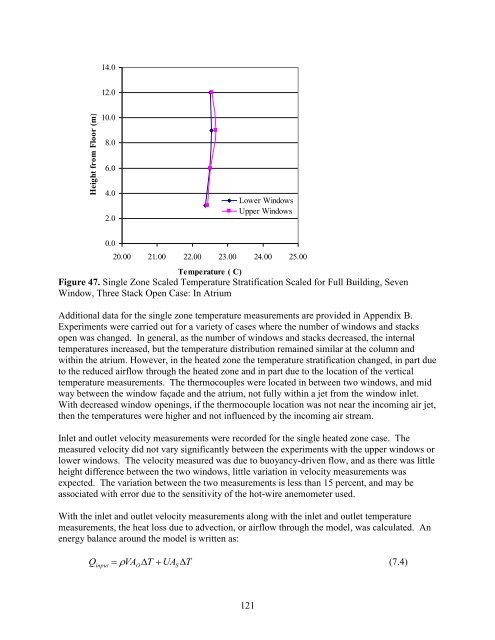Methodology for the Evaluation of Natural Ventilation in ... - Cham
Methodology for the Evaluation of Natural Ventilation in ... - Cham
Methodology for the Evaluation of Natural Ventilation in ... - Cham
Create successful ePaper yourself
Turn your PDF publications into a flip-book with our unique Google optimized e-Paper software.
Height from Floor (m)14.012.010.08.06.04.02.0Lower W<strong>in</strong>dowsUpper W<strong>in</strong>dows0.020.00 21.00 22.00 23.00 24.00 25.00Temperature ( C)Figure 47. S<strong>in</strong>gle Zone Scaled Temperature Stratification Scaled <strong>for</strong> Full Build<strong>in</strong>g, SevenW<strong>in</strong>dow, Three Stack Open Case: In AtriumAdditional data <strong>for</strong> <strong>the</strong> s<strong>in</strong>gle zone temperature measurements are provided <strong>in</strong> Appendix B.Experiments were carried out <strong>for</strong> a variety <strong>of</strong> cases where <strong>the</strong> number <strong>of</strong> w<strong>in</strong>dows and stacksopen was changed. In general, as <strong>the</strong> number <strong>of</strong> w<strong>in</strong>dows and stacks decreased, <strong>the</strong> <strong>in</strong>ternaltemperatures <strong>in</strong>creased, but <strong>the</strong> temperature distribution rema<strong>in</strong>ed similar at <strong>the</strong> column andwith<strong>in</strong> <strong>the</strong> atrium. However, <strong>in</strong> <strong>the</strong> heated zone <strong>the</strong> temperature stratification changed, <strong>in</strong> part dueto <strong>the</strong> reduced airflow through <strong>the</strong> heated zone and <strong>in</strong> part due to <strong>the</strong> location <strong>of</strong> <strong>the</strong> verticaltemperature measurements. The <strong>the</strong>rmocouples were located <strong>in</strong> between two w<strong>in</strong>dows, and midway between <strong>the</strong> w<strong>in</strong>dow façade and <strong>the</strong> atrium, not fully with<strong>in</strong> a jet from <strong>the</strong> w<strong>in</strong>dow <strong>in</strong>let.With decreased w<strong>in</strong>dow open<strong>in</strong>gs, if <strong>the</strong> <strong>the</strong>rmocouple location was not near <strong>the</strong> <strong>in</strong>com<strong>in</strong>g air jet,<strong>the</strong>n <strong>the</strong> temperatures were higher and not <strong>in</strong>fluenced by <strong>the</strong> <strong>in</strong>com<strong>in</strong>g air stream.Inlet and outlet velocity measurements were recorded <strong>for</strong> <strong>the</strong> s<strong>in</strong>gle heated zone case. Themeasured velocity did not vary significantly between <strong>the</strong> experiments with <strong>the</strong> upper w<strong>in</strong>dows orlower w<strong>in</strong>dows. The velocity measured was due to buoyancy-driven flow, and as <strong>the</strong>re was littleheight difference between <strong>the</strong> two w<strong>in</strong>dows, little variation <strong>in</strong> velocity measurements wasexpected. The variation between <strong>the</strong> two measurements is less than 15 percent, and may beassociated with error due to <strong>the</strong> sensitivity <strong>of</strong> <strong>the</strong> hot-wire anemometer used.With <strong>the</strong> <strong>in</strong>let and outlet velocity measurements along with <strong>the</strong> <strong>in</strong>let and outlet temperaturemeasurements, <strong>the</strong> heat loss due to advection, or airflow through <strong>the</strong> model, was calculated. Anenergy balance around <strong>the</strong> model is written as:Q<strong>in</strong>put VA TUAT(7.4)OS121
















